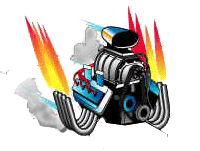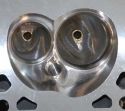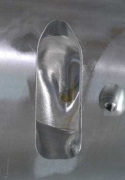ENGINE REBUILDING AUTOMOTIVE MACHINE SHOP
1- 413-583 - 4414
80 Ravenwood Drive Ludlow, MA 01056
Performance Machine Shop and Engines Since 1989
What does it take to make power? That's a question builders around the country are trying to answer every day. We know that making power takes a variety of factors working together, and we also know that a large component of the equation is airflow, plain and simple. We've all heard the old analogies about an engine being basically an air pump. However, none of us are bolting together a sensational mill to try and air up the tires. Another way of looking at it is considering the fact that air and fuel mix in an essentially fixed ratio in a performance engine, from about 12.4 to 13:1 air/fuel ratio. Getting more of this mixture into the engine is key to having more energy to burn, and making more power in the process. The ratio, which is calculated by weight, not volume, naturally means that an engine will demand large quantities of air to fill the cylinders of a high-output engine. Now, how are you going to predict a positive step towards power production without knowing how much of that precious air can find its way in via the ports, and then back out the exhaust?
Years ago, porting was largely a matter of intuition and guesswork, leading to experience. There was little in the way of test equipment to empirically evaluate flow, or to gauge the progress of a series of modifications. Largely it came down to "cut and try," and it was a little like flying blind. Sometimes, just because a modification looks good doesn't mean it results in increased airflow. The need for data led to the development of commercial flow benches. With the bench, racers and engine builders gained the tools required to gain solid information in comparative testing and modifications. Flow testing has come a long way in recent decades, and along with it, the quality of data and the power output of our engines have developed significantly. More knowledge, better techniques, and improved flow have moved the bar to where today's street engines often make more power than all-out race engines of the '60s.
Upbeat On Depression
A basic flow bench works by creating a pressure differential across the orifice, and then measuring the pressure drop via a manometer. Generally, these days we use a pressure drop equivalent to 28-inches of water in a standard manometer as a fixed pressure differential at which the flow in cubic-feet-per-minute-of-air is recorded. In the days of old, flow benches were no where near as capable in capacity as those currently manufactured. It was not uncommon for test pressure differentials as low as 3 inches of water to be used as the depression. Although cfm of airflow can be recorded at low pressure drops, it's the pressure differential, or depression, that's the force acting on the air to move it through the part being tested. Higher depressions equate to more force, and with that force, the airflow is moving at a much higher volume and velocity. Testing at a low pressure drop will produce a true measure of airflow, which can be simply converted mathematically to the equivalent flow at any other pressure differential. However, the actual flow characteristics are likely to change at higher pressure differentials, since the velocity of the airflow is increased under these test conditions.
Because of this concept, over the years the test differential has moved upward, with the currently favored 28 inches being much closer to the actual velocity conditions in a running engine. In fact, we know of some cylinder head development work done at much higher test differentials than the 28 inches normally seen. It's all to get an impression of the air behavior at higher velocities. This factor, along with the advent of higher-flowing ports, has meant that the test equipment industry has had to offer flow benches with ever increasing capacities. SuperFlow answers these requirements with a full range of flow bench capacities.
The Right Bench
The desire to quantify airflow is pretty universal in the engine building world, but the specific requirements of the end user vary widely. It's quite clear that a shop specializing in motorcycle or small-engine powerplants would have dramatically different requirements when compared to those of a Pro-Stock engine shop. To meet those varied needs, SuperFlow's lineup of flow benches vary in capacity from the baby SF-60, which will pull 90 cfm at 15 inches, to the SF-1020 ProBench, with a capacity of 1000 cfm and the ability to pull up to 65 inches of water depression. In between, SuperFlow offers the basic entry level SF-110 and the up-rated SF-120 (same basic chassis as the SF110, but with more powerful motors) for an economical machine capable of flowing performance V-8 heads, but at a reduced pressure differential at higher lifts. The real mainstay for the typical high-performance shop is the SuperFlow 600. Rated at 600 cfm at 20-inches depression, the SF-600 is just the right capacity to handle virtually all the flow-testing requirements of the professional engine builder. This unit has the range and accuracy to test any cylinder head, intake manifold, throttle body, air cleaner, or muffler-as assemblies or separate units. Consider the features:
* Bi-directional flow for intake and exhaust tests.
* Flows a maximum of 600 cfm.
* Optional second 48-inch manometer allows one to perform carburetor- signal or velocity-probe tests.
* Proven design for years of trouble-free testing.
* Available with FlowCom flow computer for faster, easier, more accurate tests, with digital readouts for corrected flow, test pressure, velocity probe, and swirl meter in English or metric units, and automati- cally regulates test pressure with optional motor controller.
* Outputs to optional Port Flow Analyzer flow bench software via serial connection to a PC.
Test Accessories And Tools
The most basic 'bench accessories include the various flow adapters, radius plates, and fixtures to mount the test piece and open the valves a measured amount. There are also many devices that can make the flow bench much more versatile for any shop. Among these items, one of the most useful is the SuperFlow FlowCom unit. The FlowCom control automatically measures the test pressure and temperature and shows corrected flow on its easy-to-read graphical display. The direct reading is a big asset when compared to reading the manometer and figuring flow percentages to calculate cfm. FlowCom can automatically regulate test pressure with the optional motor controller, allowing the test pressure to be set at the beginning of the test. FlowCom regulates the pressure for you as the valve lift (or test orifice size) is changed. FlowCom can control to test pressure or airflow (cfm).
All data can be simultaneously transmitted in real time to your personal computer via its serial or USB connection. FlowCom can communicate with WinDyn For Flow Benches and Port Flow Analyzer software for airflow data analysis. If you prefer to record results manually, you can freeze the data at each test point with the FlowCom keypad, or with a hand- or foot-operated pushbutton. A velocity probe can be connected to the FlowCom inputs to display air speeds. You can connect a strain gauge, frequency-based swirl meter, or tumble meter and FlowCom will display swirl torque or swirl per unit of flow. Essentially, FlowCom provides data already calculated and displayed or recorded, allowing testing to be accomplished in a fraction of the time needed with a manual bench. The FlowCom unit is available as a factory installed option, or it can be retrofitted on existing SuperFlow benches.
Other accessories to aid the testing procedure include software such as the Port Flow Analyzer, which records data, crunches numbers, and allows comparative analysis of various heads or modifications. Additional technology is available to make your bench even more versatile and informative, using items such as velocity probes, which allow the port to be dissected with a reference to air speed variations through various portions of the port. Additional manometers can be added for use with pitot tubes, or for referencing carb booster signal. Motor controllers are available to automatically regulate the test pressure on manual flow benches.
Super Flow Flow Bench Testing





